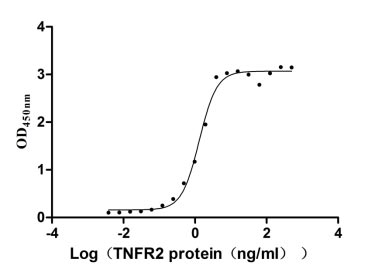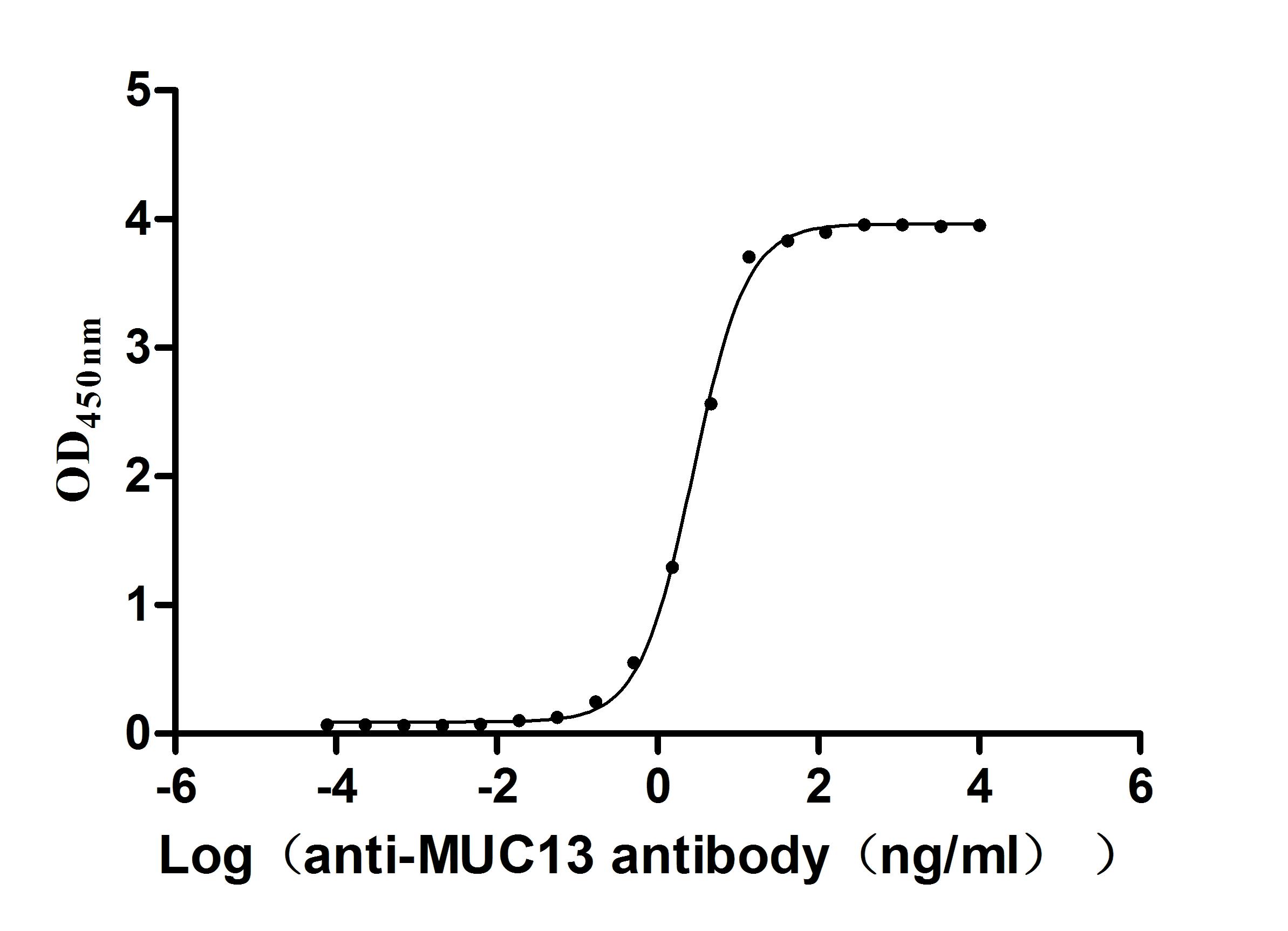Recombinant Human P2X purinoceptor 4 (P2RX4), partial
-
货号:CSB-YP859513HU
-
规格:
-
来源:Yeast
-
其他:
-
货号:CSB-EP859513HU
-
规格:
-
来源:E.coli
-
其他:
-
货号:CSB-EP859513HU-B
-
规格:
-
来源:E.coli
-
共轭:Avi-tag Biotinylated
E. coli biotin ligase (BirA) is highly specific in covalently attaching biotin to the 15 amino acid AviTag peptide. This recombinant protein was biotinylated in vivo by AviTag-BirA technology, which method is BriA catalyzes amide linkage between the biotin and the specific lysine of the AviTag.
-
其他:
-
货号:CSB-BP859513HU
-
规格:
-
来源:Baculovirus
-
其他:
-
货号:CSB-MP859513HU
-
规格:
-
来源:Mammalian cell
-
其他:
产品详情
-
纯度:>85% (SDS-PAGE)
-
基因名:
-
Uniprot No.:
-
别名:AI504491; ATP gated cation channel protein ; ATP receptor; AW555605; D5Ertd444e ; fi03f02; MGC143034 ; OTTMUSP00000023741; OTTMUSP00000023745; OTTMUSP00000023746; OTTMUSP00000023747; P2rx4; P2RX4_HUMAN; P2X purinoceptor 4; P2X receptor subunit 4; P2X4; P2X4R ; Purinergic receptor; Purinergic receptor P2X ligand gated ion channel 4; Purinergic receptor P2X4 ; Purinoceptor P2X4 ; wu:fi03f02
-
种属:Homo sapiens (Human)
-
蛋白长度:Partial
-
蛋白标签:Tag type will be determined during the manufacturing process.
The tag type will be determined during production process. If you have specified tag type, please tell us and we will develop the specified tag preferentially. -
产品提供形式:Lyophilized powder
Note: We will preferentially ship the format that we have in stock, however, if you have any special requirement for the format, please remark your requirement when placing the order, we will prepare according to your demand. -
复溶:We recommend that this vial be briefly centrifuged prior to opening to bring the contents to the bottom. Please reconstitute protein in deionized sterile water to a concentration of 0.1-1.0 mg/mL.We recommend to add 5-50% of glycerol (final concentration) and aliquot for long-term storage at -20℃/-80℃. Our default final concentration of glycerol is 50%. Customers could use it as reference.
-
储存条件:Store at -20°C/-80°C upon receipt, aliquoting is necessary for mutiple use. Avoid repeated freeze-thaw cycles.
-
保质期:The shelf life is related to many factors, storage state, buffer ingredients, storage temperature and the stability of the protein itself.
Generally, the shelf life of liquid form is 6 months at -20°C/-80°C. The shelf life of lyophilized form is 12 months at -20°C/-80°C. -
货期:Delivery time may differ from different purchasing way or location, please kindly consult your local distributors for specific delivery time.Note: All of our proteins are default shipped with normal blue ice packs, if you request to ship with dry ice, please communicate with us in advance and extra fees will be charged.
-
注意事项:Repeated freezing and thawing is not recommended. Store working aliquots at 4°C for up to one week.
-
Datasheet :Please contact us to get it.
相关产品
靶点详情
-
功能:Receptor for ATP that acts as a ligand-gated ion channel. This receptor is insensitive to the antagonists PPADS and suramin.
-
基因功能参考文献:
- Three single nucleotide polymorphisms (SNPs) within P2X4R and two SNPs within CAMKK2 influenced concentrations of TNFalpha in peripheral blood mononuclear cells, but these SNP did not associate with risk for HIV-associated sensory neuropathy in South Africans. PMID: 29428485
- the data reveals a role for P2X4 in determining the duration of ATP-evoked Ca(2+) responses and CXCL5 secretion in human primary macrophage. PMID: 29255078
- the data provides evidence that P2X4 is functionally expressed in THP-1 differentiated macrophages as reflected from their contribution towards ATP-evoked Ca2+ response, but their functional evidence in THP-1 monocyte is lacking. PMID: 29077063
- Our study nominates rare genetic variants in P2RX4 and P2RX7 as major genetic contributors to disease, further supporting a role for these purinergic receptors in MS and the disruption of transmembrane cation channels leading to impairment of phagocytosis as the pathological mechanisms of disease PMID: 28326637
- Overexpressing P2X4Rs on microglia are a central player in evoking neuropathic pain. (review) PMID: 28458288
- the intersubunit physical couplings among the DF and two lower body domains fostered by the LF domain at the open state act as an integrated structural element that is stringently required for the channel gating of P2X4 receptors. PMID: 28302727
- These findings provide new insights in understanding the contribution of the salt bridge between Asp-85 and Arg-309 and its structurally coupled beta2,3-sheet to the function of P2X4 receptors. PMID: 26865631
- The results suggest a role of PrP(C) in proteostasis, dysfunctions of which may be involved in the pathogenesis of neurodegenerative diseases such as TSE and Alzheimer's Disease. PMID: 26946358
- Fndings support role for P2X7 and P2X4 coupled to induction of inflammatory molecules in modulating high glucose and palmitate-induced endothelial cell activation and dysfunction. PMID: 25938443
- This study demonstrates a major physiological finding that the shear-induced effects on endothelial KLF2 axis are in part dependent on ATP release and P2X4, a previously unidentified mechanism. PMID: 25563726
- Using pHluorin, P2X4 was found to be expressed on the plasma membrane and within subcellular compartments in hippocampus. PMID: 24935743
- It appears to mediate the cells' response to extracellular ATP. Although Ca2thorn influx via P2X1 receptor is necessary for alpha-synuclein accumulation. PMID: 25480524
- P2X4 and calmodulin form a complex at endolysosomal membrane where P2X4 activation recruits calmodulin to promote fusion and vacuolation in a Ca(2+)-dependent fashion. PMID: 26101220
- the lysosome-localized P2X4 may play specific roles in membrane trafficking of acidic organelles in mammalian cells. PMID: 24817123
- P2X4 assembles with P2X7 and pannexin-1 in gingival epithelial cells and modulates ATP-induced reactive oxygen species production and inflammasome activation during P. gingivalis infection. PMID: 23936165
- Results suggest that ATP-P2X4 signaling mediates high glucose-induced activation of the NLRP3 inflammasome. PMID: 23434541
- These findings highlight Rab5 GTPase as a key regulator of P2X4 receptor cell surface expression and internalisation PMID: 23086000
- This is the first study demonstrating an association of non-synonymous polymorphisms in the P2RX ( 4 ) and the risk of osteoporosis, suggesting a role of the P2X ( 4 ) R in the regulation of bone mass PMID: 23138503
- results demonstrate that a haplotype including two rare variants in P2RX7 and P2RX4 confers a functional interaction between these two variant receptors that impairs the normal scavenger function of macrophages and microglia PMID: 23303206
- IL-18 associates to microvesicles shed from human macrophages by a LPS/TLR-4 independent mechanism in response to P2X receptor stimulation. PMID: 22996386
- The present article highlights the recent advances in our understanding of microglia-neuron interactions in neuropathic pain by focusing on the signaling and regulation of the P2X4R--{REVIEW} PMID: 22528681
- We demonstrate here that stimulation with ADP or ATP induces significant reversible inhibition of C. trachomatis development in cervical epithelial cells through stimulation of the purinergic receptor P2X4. PMID: 22988022
- found that pharmacological inhibition of P2X4 receptors with TNP-ATP inhibited transcriptional up-regulation of TNF-alpha and IFN-gamma in gammadelta T cells stimulated with anti-CD3/CD28-coated beads PMID: 22753954
- Neuropathic pain may be driven by P2X4R+ microglia. PMID: 22837036
- Allosteric modulation of Ca2+ flux in ligand-gated cation channel (P2X4) by actions on lateral portals PMID: 22219189
- Transcripts of five different isoforms of P2X4 receptors are expressed in human liver cells indicating that they represent an important component of the purinergic signaling complex in HCV induced liver pathogenesis. PMID: 21899776
- The Tyr315>Cys mutation (rs28360472) reduced the peak amplitude of the ATP-induced inward current. In Victorian Family Heart Study participants, 1 minor allele increased pulse pressure by 2.84 mm Hg. PMID: 22068874
- Owing to their favorable diameters and equivalent spacing, the lateral portals split the task of ion supply threefold and minimize an ion's diffusive path before it succumbs to transmembrane electrochemical gradients PMID: 21808018
- we have identified an extracellular signaling pathway where Tbeta4 increases cell surface ATP levels via ATP synthase and have shown further that ATP-responsive P2X4 receptor is required for Tbeta4-induced cell migration PMID: 21106936
- These data have identified the first transcription factor involved in P2X receptor expression. PMID: 19953327
- Results show that P2X4 and P2X6 receptors are associated with VE-cadherin at HUVEC adherens junctions. PMID: 12088286
- shear stress stimulates pulmonary artery endothelial cells to release ATP, which activates Ca2+ influx via P2X4 receptors. PMID: 12714321
- We have identified a distinct subpopulation of P2X4-positive macrophages infiltrating the dystrophic fibres. These cells were absent from normal muscle and rarely present in the dystrophic muscle taken before and after the onset of degeneration. PMID: 15006691
- Increased contractility likely underlies survival benefit from P2X4 receptor overexpression. PMID: 15130891
- in human parotid acinar cells, in addition to modulation of Ca(2+) release, Ca(2+) influx through P2X(4)R may constitute a further locus for the synergistic effects of Ca(2+) and PKA activation. PMID: 15262999
- wild-type desensitization properties requires an aromatic moiety at position 374 and an amino rather than a guanidino group at position 373 PMID: 16533808
- P2X4 receptor-specific residues contribute to the ivermectin effects on channel deactivation PMID: 16949036
- Main role for P2X(4) receptor in nucleotide-induced apoptosis in human mesangial cells, indicating a relevant role for purinergic signaling in regulating death rate in these cells. PMID: 17264311
- This review discusses the need to reinterpret the assumed "go-it alone" function of the P2X7 receptor in light of convincing biochemical and electrophysiological evidence for the existence of P2X4/P2X7 heteromeric receptors. PMID: 17895406
- support a common site of ATP action at P2X receptors and suggest that non-conserved residues also play a regulatory role in agonist action PMID: 18487206
- analysis of molecular shape, architecture, and size of P2X4 receptors PMID: 18635539
- INF-gamma selectively increases P2X4-receptor gene expression, leading to an up-regulation of purinergic signaling in vascular endothelial cells. PMID: 18678988
- P2X(4) and P2X(7) receptors are expressed by human osteoblast-like cells. P2X(7) receptor is mainly responsible for pore formation although P2X(4) receptors may also be involved. PMID: 19226284
- This study presents a picture whereby P2X(4)R become functional in response to initial phagocytic stimuli but return to a non-functional state during sustained activation by classical macrophage activation. PMID: 19283779
- Results suggest that amyloid beta(1-42)-induced synaptic dysfunction and neuronal death may involve perturbations in P2X4 purinergic receptors. PMID: 19562525
显示更多
收起更多
-
亚细胞定位:Membrane; Multi-pass membrane protein.
-
蛋白家族:P2X receptor family
-
数据库链接:
HGNC: 8535
OMIM: 600846
KEGG: hsa:5025
STRING: 9606.ENSP00000336607
UniGene: Hs.321709
Most popular with customers
-
Recombinant Human Tumor necrosis factor receptor superfamily member 1B (TNFRSF1B), partial (Active)
Express system: Mammalian cell
Species: Homo sapiens (Human)
-
Recombinant Human Signal transducer CD24 (CD24)-Nanoparticle (Active)
Express system: Mammalian cell
Species: Homo sapiens (Human)
-
Recombinant Rat Gastric inhibitory polypeptide receptor (Gipr), partial (Active)
Express system: Mammalian cell
Species: Rattus norvegicus (Rat)
-
Recombinant Human Kidney-associated antigen 1(KAAG1) (Active)
Express system: E.coli
Species: Homo sapiens (Human)
-
Recombinant Human Mucin-13(MUC13),partial (Active)
Express system: yeast
Species: Homo sapiens (Human)

















